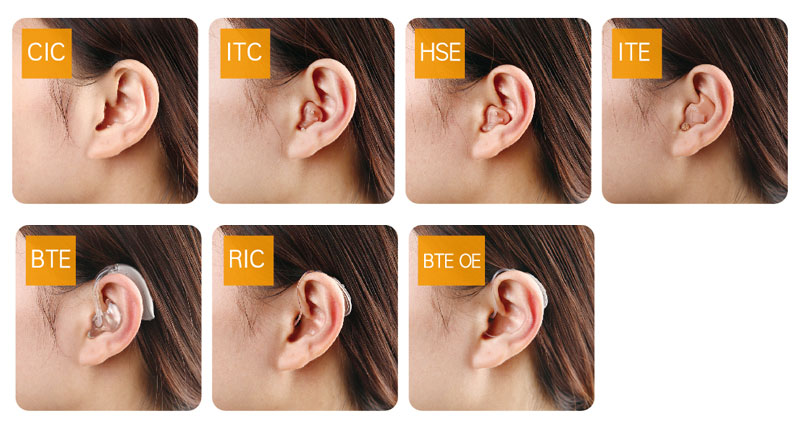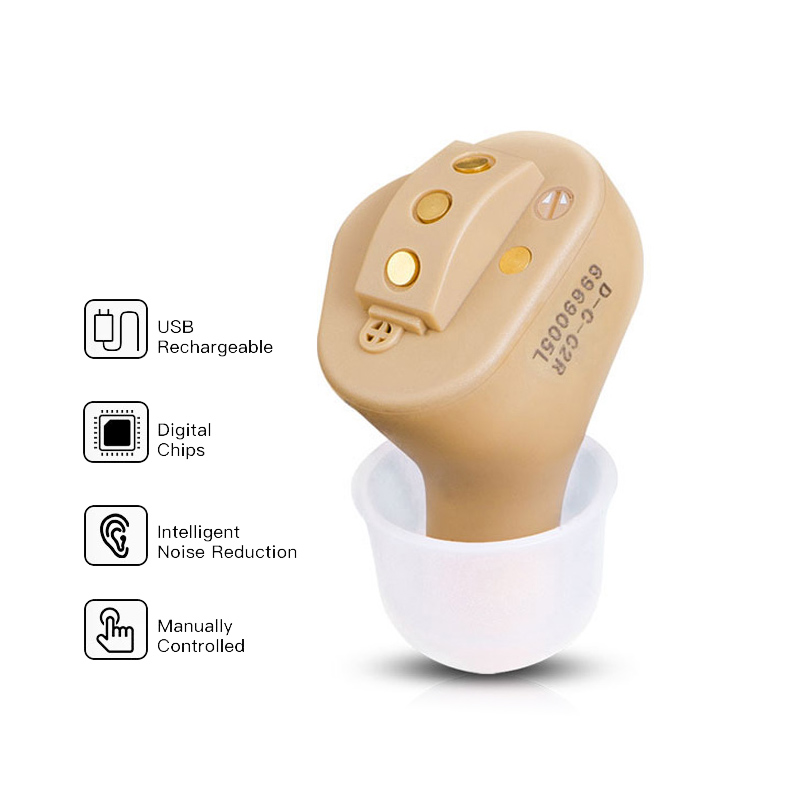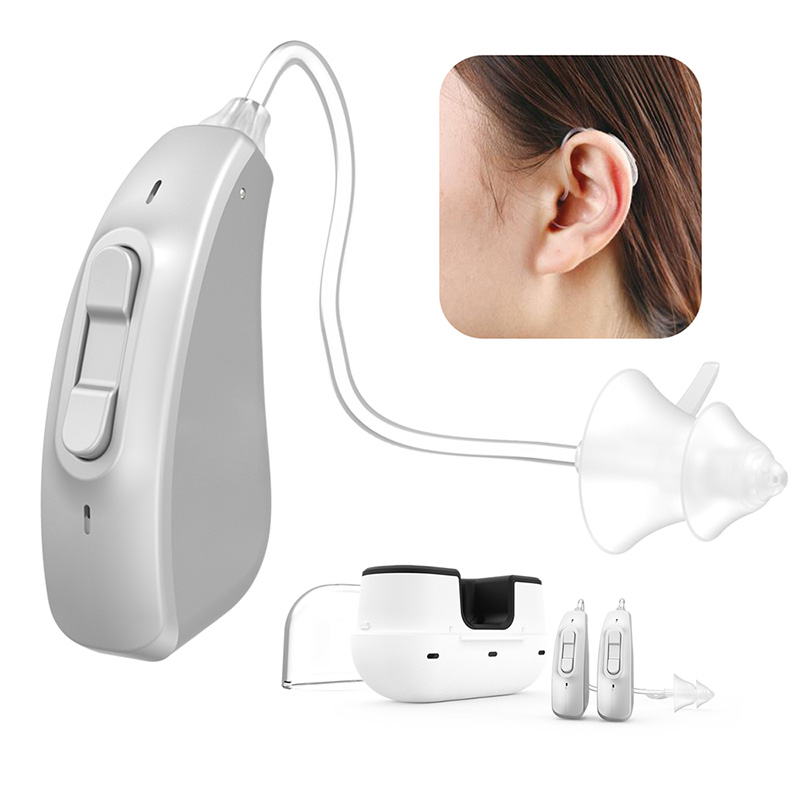HOW TO CHOOSE THE RIGHT HEARING AID PRODUCT?
There are many common types of hearing aids on the market, including fully in-ear hearing aids, canal hearing aids, in-the-ear hearing aids, behind-the-ear hearing aids, glasses hearing aids, box hearing aids and other types. So what are the factors that need to be considered when choosing a hearing aid type?
Spieth feels that it is important to consider not only the advantages and disadvantages of the different types of hearing aids, but also many objective and subjective factors of the user himself. Let’s take a look at the factors that need to be taken into consideration when choosing a hearing aid.
Discreetness and aesthetics
When choosing a hearing aid based solely on its appearance, most users consider this issue first and require a good concealment so that bystanders do not easily notice that they have a hearing problem. From this point of view, CIC is the easiest to meet the user’s needs, and ITC is the next best.
Ease of Wear and Use
Most elderly users as well as some young people with optimistic personalities will prefer the ease of wearing and using hearing aids when faced with a choice.
From a wearing point of view, ITE, ITC and CIC hearing aids are easier to wear, as the whole hearing aid is in one device and does not interfere with the glasses.
From the adjustment point of view, it is difficult for the wearer to adjust the CIC in the ear canal directly. Box, spectacle and behind-the-ear hearing aids are relatively easy to adjust, relatively large and easy to operate. Nowadays, there are few analog hearing aids on the market, and most users choose digital hearing aids controlled by computer programming, which generally do not require direct volume adjustment and can be adjusted by remote control devices, making it more convenient to use.
In addition, some users with chronic infections are more suitable to use behind-the-ear hearing aids, not ITE, ITC, CIC.
Cost problem
When users choose hearing aids, they always ask for hearing aids with good performance and low price. In the current hearing aid industry, with the continuous development of hearing technology and the upgrading of new technology, users can always find a hearing aid that is relatively cost-effective and better meets their requirements and suits their needs under the guidance of a professional dispenser.
The problem with high gain and maximum output
Generally cassette and behind-the-ear hearing aids are more powerful than canal hearing aids because the further the microphone is from the receiver, the greater the gain without feedback. The size of the receiver and battery is also relatively large, making the size of the hearing aid, and the maximum output, also relatively increased.
Lifespan of hearing aids
Reliability of hearing aid hardware. Hearing aids with the receiver placed in the ear canal are the least reliable, as cerumen and moisture limit the time the receiver can be used.
Some of the BTEs with VC fine-tuning on the back of the machine are more susceptible to perspiration and thus affect the life span. The type of hearing aid should be selected according to the different psychology of the user and the environment in which the hearing aid will be used.
Blocked ears and feedback problems
In the traditional sense, the low-frequency hearing threshold is close to normal, and the high-frequency hearing loss is difficult to match satisfactory users. The user’s low-frequency hearing threshold requires a large vent to reduce the plugging effect, but the high-frequency hearing threshold requires a large gain, which can easily cause feedback whistling. ITE, ITC, and CIC all produce the plugging effect. Currently there are advanced technology hearing aids in hearing aid design with advanced treatment methods specifically for the blocked ear and feedback problem. For example, to solve the high frequency steep drop type hearing problem, the audibility extension function can be used to perceive the high frequency sound through the lower frequency hair cells; to solve the blocked ear problem, in addition to the traditional methods, the blocked ear effect manager or optional open hearing aid, receiver ear canal receiving type hearing aid ( RIC), etc.
Special functional requirements of the user
Telephone compatibility; larger hearing aids can have inductive coils inside the body to pick up the magnetic signal from the telephone.Inductive mode is available for BTE and cartridge hearing aids. However, the telephone handset must be placed close to the main unit, adding to the complexity of use. ITE, ITC can have additional inductive selection buttons, but this makes the panel crowded and increases the difficulty of control. Alternatively, a program can be designed as an inductive program if the hearing aid already has a program selection button. And most CICs, and some ITCs, can place the microphone on the ear and the hearing aid will play a loud signal without the user having to select an inductive mode. With the advent of wireless hearing aids, the advanced wireless technology directly connects the cell phone to the hearing aid through the remote control to adjust, thus achieving simultaneous listening to the receiver in both ears and shielding the interference from the noisy external environment, and freely answering and using the cell phone.
Insensitivity to wind noise: Most wind noise comes from turbulence generated in the head and ear. the CIC picks up less wind noise than other hearing aids because its microphone is far from the site of turbulence generation. BTE hearing aids are most affected by turbulence. However, many behind-the-ear hearing aids now have a change in their top design that can greatly reduce the effect of wind noise.
Directionality; BTE and ITE, and some ITCs can accommodate directional microphones. There are now behind-the-ear hearing aids that have incorporated microphone technology that has increased directionality and speech intelligibility. When considering only fully directional microphones, CIC has the best directionality, followed by ITC, as these hearing aids make good use of the sound collection and attenuation effects of the head, pinna and earnail. As microphone technology continues to advance, high-precision localization systems in ear canal and behind-the-ear machines can now detect speech noise signals in the environment in real time and analyze the signal more finely to further improve speech intelligibility.
Battery size: The smaller the battery, the more difficult it is to operate and the time it takes to use it decreases. Most people with hearing loss are older, and they will have some difficulty operating smaller objects. The degree of difficulty users have in operating different types of hearing aids has a lot to do with their ultimate satisfaction rate with each type of hearing aid. The larger the battery, the greater the power storage and the longer the time with the machine, the more convenient for the user while saving money.





评论
发表评论